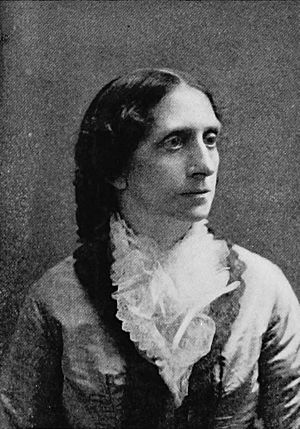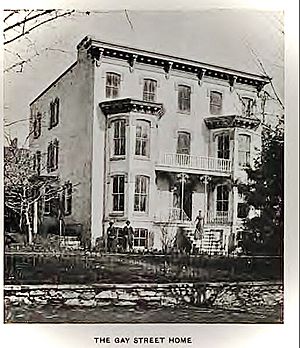Angeline Stickney facts for kids
Quick facts for kids
Angeline Stickney
|
|
|---|---|
 |
|
| Born | November 1, 1830 |
| Died | July 3, 1892 (aged 61) |
| Nationality | American |
| Alma mater | New-York Central College |
| Occupation | Teacher, suffragist, and mathematician |
| Spouse(s) | Asaph Hall |
Angeline Stickney Hall (born November 1, 1830 – died July 3, 1892) was an amazing American woman. She was a teacher, a mathematician, and fought for women's rights. She taught others and later married the famous astronomer Asaph Hall. Most people knew her as Angeline Stickney Hall. The biggest crater on Phobos, one of Mars' moons, is named Stickney after her. This honors her help in discovering the moons.
Contents
Angeline's Early Life and Education
Angeline Stickney was born on November 1, 1830. Her parents were Theophilus Stickney and Electa Cook. When she was 17, her cousin Harriette Downs helped her study at Rodman Union Seminary.
Later, Angeline went to New-York Central College. Her sister Ruth helped her, and Angeline also taught there to pay for her studies. She studied science and math, including advanced topics like calculus. She was part of the college's very first graduating class in 1855.
New-York Central College was a special school for its time. It allowed students from all backgrounds to get a college degree. This included women and free African Americans. While there, Angeline became very passionate about two important causes: women's right to vote (women's suffrage) and ending slavery (abolition).
Meeting Asaph Hall
Angeline Stickney met Asaph Hall at New-York Central College. Angeline was two years ahead of Asaph in her studies. She even taught him geometry and German! Asaph and his friends would try to come up with math problems they thought Angeline couldn't solve. But she always found the answer!
Angeline and Asaph got married in Elkhorn, Wisconsin, on March 31, 1856. Back then, it was common for women to stop their careers after marriage. So, Angeline stopped teaching after they wed.
Right after their wedding, they moved to Ann Arbor, Michigan. Asaph continued his education at the University of Michigan. Three months later, they moved to Shalersville, Ohio. Angeline even wrote to Asaph's boss, Captain Gillis. She successfully suggested that Asaph should become a professor at the Naval Observatory.
Discovering Mars' Moons
Angeline played a very important role in a big discovery! Asaph Hall was looking for moons around Mars. He was about to give up, but Angeline encouraged him to keep searching. Because of her encouragement, he successfully discovered the two moons of Mars: Phobos and Deimos!
Angeline also helped Asaph with his calculations. She asked to be paid the same as a man for her work. When Asaph said no, she stopped helping with the calculations.
The largest crater on Phobos is named Stickney Crater in her honor.
Angeline's Family
Angeline Hall taught all four of her children at home. This was called home-schooling. All her sons later went to Harvard University.
- Her oldest son, Asaph Hall, Jr., was born in 1859. He became the director of the Detroit Observatory from 1892 to 1905.
- Her third son, Angelo Hall, became a minister. He wrote a book about his mother's life.
- Her fourth son, Percival Hall (1872–1953), became the second president of Gallaudet University. This university is famous for educating deaf and hard-of-hearing students. Percival himself was not deaf.
Angeline Stickney Hall passed away in North Andover, Massachusetts, when she was 61 years old.
See also
 In Spanish: Angeline Stickney para niños
In Spanish: Angeline Stickney para niños


